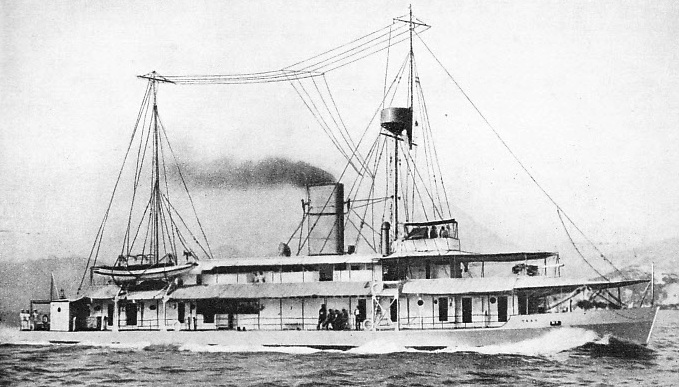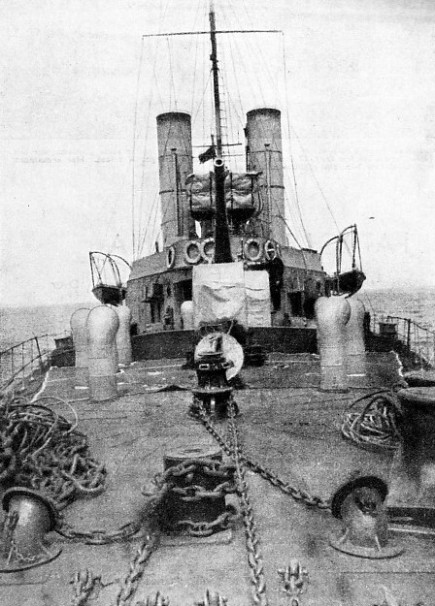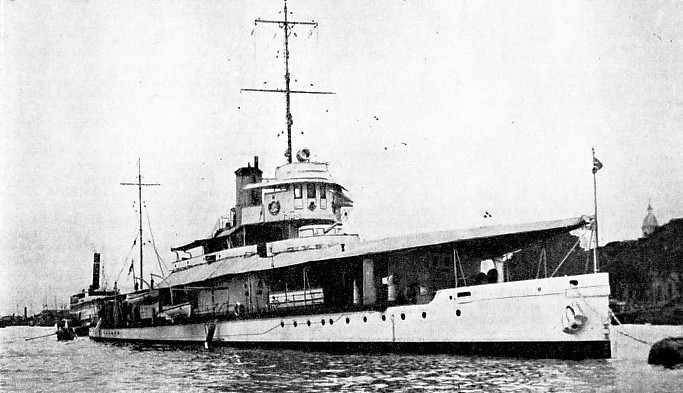

© Shipping Wonders of the World 2012-

Gunboat Patrols in China
The Yangtse Gunboat Patrol is a section of the Royal Navy which is always on active service. Over a stretch of 1,300 miles of river these interesting units protect civilians of every nationality from the attentions of numerous bands of pirates

A SPEED OF 14 KNOTS is given by the 1,370-
NOT many people know that British warships are always on patrol in the heart of China. They are units of the Yangtse Gunboat Flotilla, which forms part of the China Squadron, but is under the direct command of a rear-
From the mouth of the river at Shanghai to Hankow is a run of 600 miles, and this is easily the most civilized area. Between Hankow and Ichang, a distance of about 500 miles, the country becomes more primitive and lawless. The last stretch of the gunboats’ beat is from Ichang to Chungking, on the Upper River, where navigation is rendered dangerous by rapids and swift currents. The Yangtse Kiang is described in the chapter “China’s Mighty River”.
Not counting Shanghai, where there is a large British community, there are nine considerable towns on the Yangtse, each with its quota of British residents — folk and missionaries — and British interests. There are also two large British shipping companies which maintain regular passenger and cargo services up and down the whole navigable length of the river, and a third firm which transports oil.
The gunboat patrol was inaugurated many years ago to protect these widely scattered British communities and properties, but it is at all times ready to assist the nationals of other countries who may be in danger or distress. As the gunboats by themselves are neither numerous nor strong enough to cope with all emergencies, one cruiser is usually stationed at Hankow and another at Nanking to give support if required. American and Japanese gunboats also patrol the Yangtse Kiang, but the British gunboat flotilla is by far the largest.
Several of the British gunboats engaged in this work were built specially for the purpose and sent to China in sections, to be reassembled at Shanghai or Hong Kong. Others were built during the War of 1914-
The armament consists of two 6-
positions. Coal and oil are burned in the furnaces, and the designed speed is 14 knots, though this has been exceeded in service. Every vessel has a complement of sixty officers and men.
The smaller gunboats are named after birds — such as Falcon, Gannet, Seamew and Robin — and range from 185 to 372 tons, with speeds of 11 to 16 knots and an armament of 3-
The largest of the group of smaller gunboats is the Falcon. She has a displacement of 372 tons and was completed in 1931. Her geared turbines develop 2,250 horse power and give her a speed of 15 knots. Most recent is the Robin, laid down in 1933 and completed during the following year. She is a slower boat, with a displacement of 226 tons. Her reciprocating engines have a designed horse-
Except when lying at her base, every gunboat of the Yangtse patrol is always ready for immediate action. Traffic on the river is heavy. Big ocean steamers go up as far as Hankow, and above and below that city there is a constant procession of junks, lighters and river craft. Collisions are of common occurrence, and many Chinese families hurled into the eddying brown waters of the river owe their preservation to the prompt action of a passing British gunboat. Piracy, too, though less rife nowadays than in former times, is not extinct. An incident such as the following is not infrequent.
The crew of a gunboat steaming towards Ichang noticed a great commotion among a group of big sailing junks at anchor. The captain stopped to inquire into the trouble. He learnt that only half an hour earlier the junks had been boarded by pirates from a tug, and that they had removed the most valuable cargo and had made off down river, taking with them a rich merchant and several girls.
Although this was, strictly, a matter for the Chinese police — of whom, incidentally, there was no sign — the gunboat captain did not hesitate. The pirates who had attacked the junks might later turn their attention to a British ship, and that would be essentially the gunboat’s business. So she promptly swung round in pursuit of the piratical tug and before long overhauled her.
When the pirates saw the British ship bearing down on them, her forward 3-
 During the periodic outbreaks of civil war in China, life in the Yangtse gunboats becomes decidedly eventful. At any hour of the day or night they are liable to be fired on from the banks by irresponsible soldiery, and to have bullets whistling overhead or rattling on the armour-
During the periodic outbreaks of civil war in China, life in the Yangtse gunboats becomes decidedly eventful. At any hour of the day or night they are liable to be fired on from the banks by irresponsible soldiery, and to have bullets whistling overhead or rattling on the armour-
ONE 3-
On many occasions the presence of a gunboat has saved riverside hamlets from being raided by marauding bands belonging to one or other of the opposing “armies”; for, while British officers on the Yangtse never interfere in local politics, the would-
It is safe to say that if for any reason the gunboat patrol were withdrawn, peaceful traffic on the great river would eventually come to a standstill. In the opinion of a British admiral who formerly commanded the gunboat flotilla, it has been for many years the one bulwark which has prevented utter chaos in China. “It has enabled merchants, both foreign and Chinese, to continue to function in the most surprising way, and it is an astounding fact that, in spite of revolution, bandits, pirates, pestilence and famine, the Maritime Customs returns show an annual advance”.
Twenty-
Especially in the Upper River, where currents sometimes run with the speed of a mill race, navigation is difficult and, as the channels are constantly shifting, the charts need to be frequently revised. There is danger alike in summer, when the river is high, and in winter, when the level falls and many channels dry up. In either event the gunboat pilot must feel his way cautiously. When the river is in flood and the banks have disappeared, he may find himself stranded in a field, his ship immovable till the next season. Navigation, however, is not the only art in which officers of the Yangtse patrol become proficient. At the end of a two years’ commission most of them are accomplished diplomatists, for their duties bring them into contact with all sorts and conditions of people, from tuchuns, or war lords, governors and priests down to the humble sampan men.
Sometimes a situation arises when consummate tact is needed to avoid trouble. At other times firmness and resolution are called for, and in the last resort the commanding officer of a gunboat may have to make a show of force.
The Yangtse Patrol in Action
Generally he has to act on his own responsibility, for in the kaleidoscope of Chinese politics the local situation may change from day to day and, should an emergency arise, there may be no time to seek fresh orders.
The risks run by the Yangtse patrol were exemplified by the tragic affair at Wanhsien during September 1926. Wanhsien is a port on the Upper River, above Ichang, and at that date civil war was raging in the province concerned. The local general accused a British steamer of having run down two sampans crowded with his troops, many of whom were drowned. As a reprisal he seized two other British steamers and imprisoned on board six British mercantile marine officers. Three hundred Chinese soldiers were billeted in the ships, and as an extra precaution against recapture the general mounted a field battery and several machine-
The gunboat Cockchafer was lying at Wanhsien when this incident occurred. Her commanding officer, however, was unable to take action, first because his orders forbade him to interfere in the civil conflict, and secondly because his ship was not only lying within pointblank range of the field guns, but was also covered by the rifles of several hundred soldiers in concealed positions. This intolerable situation persisted for several days, and at length, when all attempts at peaceful negotiation had failed, the senior British naval officer at Ichang decided to use force.

MOORED IN THE RIVER. The gunboat Moth is one of eleven warships built during the war of 1914-
An expedition consisting of the gunboat Widgeon and the steamer Kiawo, the latter manned by officers and ratings from the cruiser Despatch and the gunboats Mantis and Scarab, went to Wanhsien with orders to rescue the six mercantile officers and, if possible, retake the two steamers. When approaching Wanhsien the ships came under heavy fire from field guns, machine-
So hot was the Chinese fire that it was impossible to recapture the two steamers, but, thanks to the diversion, the Cockchafer was able to escape from her dangerous position and reach her consorts, her guns joining with theirs in action against the Chinese batteries. Under cover of this cannonade the expedition withdrew down the river, having lost three officers — including Commander F. C. Darley — and four seamen killed and six others wounded. Although only partly successful, this bold stroke seems to have impressed the Chinese general, for a few days afterwards he released the two steamers unconditionally.
Piracy is endemic on the great river. Whenever a particularly severe outbreak is reported, the gunboats provide armed guards for British vessels, a precaution which is always effectual. River pirates scarcely ever operate from vessels of their own. Their favourite method is to join a ship in the guise of harmless passengers and, when she is well under way, rise and overpower the officers and crew. Then the ship is looted at leisure and finally abandoned, the pirates carrying off any passengers who impress them as being good for ransom by their friends.
The West River Patrol, which operates from Hong Kong, has frequent encounters with pirates, who appear to be more enterprising than their fellows of the Yangtse. Recently the gunboat Cicala came to the rescue of a cargo vessel which was attacked in broad daylight by five boatloads of pirates.
The Cicala opened fire with machine-
Pirates Checkmated
Although river gunboats were not directly concerned, the Tungchow affair, early in 1935, provided a splendid example of the protection which the British Navy gives to the helpless of all nations in far-
When it became known at Shanghai that the Tungchow was overdue the Royal Navy immediately took a hand. Within three hours all the anti-
She was heading for Bias Bay, the notorious pirates’ lair only fifty miles from Hong Kong. But as soon as the aircraft appeared and circled overhead the pirates knew that the game was up. They hurriedly escaped in the ship’s boats and a captured junk. Meanwhile a British destroyer came up with the Tungchow and escorted her back to Hong Kong. The pirates are said to have treated their captives with a certain rough kindness, but that does not alter the fact that for three days the children and their guardians were at the mercy of a gang of cut-

A RIVER GUNBOAT ON A SLIPWAY FOR REPAIRS. The hull of the Sandpiper, as with other gunboats of this type, is specially designed for navigation on the Chinese rivers and is fitted with three rudders. The Sandpiper has a displacement of 185 tons and was completed in 1933 She is 160 feet long, with a beam of 30 ft. 8 in. and a draught of under 2 feet. This shallow draught is necessary because of the shallow waters encountered in the upper reaches of the Yangtse Kiang.
You can read more on “China’s Mighty River”, “Chinese Piracy” and “The Kung Wo” on this website.